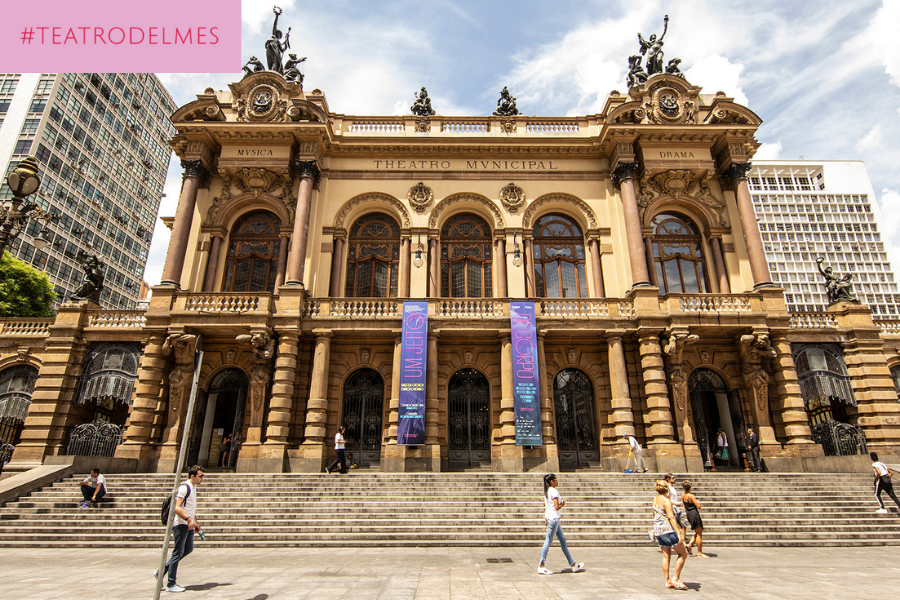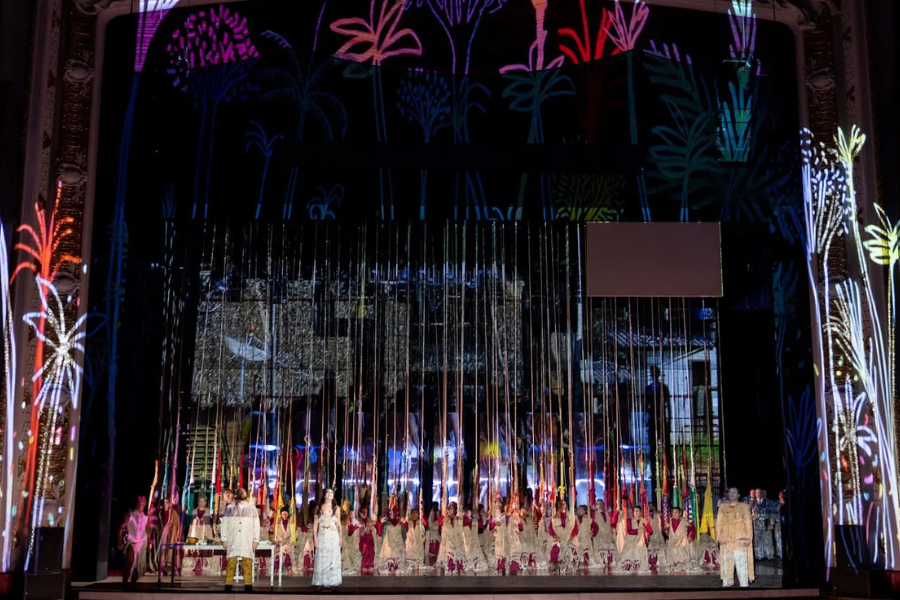Theater of the Month: Theatro Municipal de São Paulo, a historical luxury

We continue with our new section “Theater of the Month”, in which we highlight the history and architectural value of the theaters that make up our network. In this edition, we present the Municipal Theater of São Paulo.
Founded on September 12, 1911, the São Paulo Municipal Theatro stands in the center of the city, amid the bustle and cosmopolitan life of the São Paulo capital. In 1922, the complex hosted the iconic “Week of 22,” an event that lit the fuse for the Brazilian Modernist movement. Today, the complex houses, among other artistic bodies, the São Paulo Municipal Symphony Orchestra and the São Paulo City Ballet, in addition to having a solid pedagogical and artistic training project. With an architecture that intertwines Renaissance, Baroque and Art Nouveau styles, this theater is a national heritage of Brazil that recounts the exuberant and turbulent cultural history of São Paulo.
In 1912, the Brazilian poet Oswald de Andrade returned from Europe to his native São Paulo. He had just finished a brief tour of countries such as France, Italy, Germany and England, where he soaked up the ambitions that the European avant-gardes were spreading as a new artistic breath across the continent. Observing the conflicts and tumult that had arisen between the incipient Brazilian modernists and the country’s nationalist conservatism, he declared, with the manifest influence of Marinetti’s futurism: “We are fifty years behind in culture, still wallowing in full Parnassianism.”
Ten years later, Oswald de Andrade and Mário de Andrade (unrelated despite sharing last name) were in charge of producing and promoting the Modern Art Week in São Paulo. The emblematic art festival was held at the Municipal Theater of São Paulo, which was celebrating its first decade of existence as the central axis of São Paulo’s cultural activity. However, the “Week of 22” was not without controversy. The artists were booed and bombarded by certain conservative arts groups, who viewed with suspicion the artistic radicalization that the movement proposed. Writers linked to the Brazilian Academy of Letters or of a nationalist court, such as José Monteiro Lobato, attacked and roundly condemned the festival.
Despite the conflicts between the nascent avant-garde and the Brazilian establishment, the Modern Art Week signified a renewal in the language and arts of Brazil. It also reflected the cosmopolitan vocation of a city that over time became a cultural nerve center in Latin America. And the cornerstone of that São Paulo artistic spirit and energy was the Municipal Theater of São Paulo.
Story
At the beginning of the 20th century, Brazil was still in the early years of its formation as a republic after the abrupt end of the empire. Until then, São Paulo was an important coffee export center and its economy was a vital input for the development of the country. The landowners and the São Paulo aristocracy, initially reluctant to industrialization processes, sought to maintain their influence on the culture and aesthetics of the city.
Around 1903, the elite demanded the construction of a building for the arts that met international standards and was on a par with the great European theaters. After the fire that disabled the old São José Theater forever, the city needed a new stage to house the world’s great opera productions and shows. The mission was entrusted to the office of the engineer Francisco de Paula Ramos de Azevedo, who, with the help of the Italian architects Claudio and Domiziano Rossi, shaped a spectacular and unpublished building whose Renaissance and Baroque opulence shone in the so-called Morro do Chá o “Hill of Tea” of São Paulo.
The play was a sight to behold. Ramos de Azevedo took the Palais Garnier in Paris as a reference to shape the new São Paulo coliseum which, in the following years, received the opera productions that Europe exported to Latin America.
In 1911, eight years after its construction, the Municipal Theater of São Paulo finally opened its doors to the public. On September 12, the most prominent personalities of São Paulo society gathered for the inauguration of the theater. The opening performance was a performance of the French grand opera Hamlet, by the composer Ambroise Thomas, with a spectacular staging. However, the critics of São Paulo were not entirely happy. The nationalist loopholes that transcended the end of the Brazilian empire were present and specialists and critics demanded that the program also include a national work.
Until then, the most renowned composer in Brazil was Carlos Gomes (1836 – 1896). And it was not just a coincidence; he was the first Latin American composer whose works were accepted in Europe. His most famous work, the opera El guaraní, premiered at La Scala in Milan in 1870 and from then on Gomes became a benchmark in Brazilian music.
With the intention of endowing the inauguration of the Municipal Theater of São Paulo with a patriotic component, the overture of El guaraní was the piece that opened the program on the night of September 12, 1911 and then continued with Thomas’s Hamlet. The show was a great success. The city’s ruling class was shocked and expectations – already high – were far exceeded. At last, a theater had arrived in the city that fulfilled the cosmopolitan ambitions of São Paulo society.
In its first 14 years, the São Paulo Municipal Theatro presented 88 operas by 41 composers of national and international origin. Until 1926, the theater had organized around 270 performances on its stage and was already imposing itself on the Latin American and international lyrical scene.
In the middle of the 20th century, the industrial development of São Paulo was present in the architecture of the city. New and modern buildings were the living example of the development of a city that was boiling and gradually became one of the most emblematic megalopolises in Latin America. Urban growth began to contrast with the Renaissance, baroque and art nouveau legacy of the Theatro Municipal de São Paulo, losing part of its characteristic opulence in the midst of skyscrapers such as, for example, the Altino Arantes building, the “Empire State” of São Paulo .
The theater found itself head-on with progress. During the 1950s, Mayor Jânio Quadros commissioned the first major remodeling of the building to polish it as part of the Fourth Centennial of the city of São Paulo. But the social and cultural transformations in Brazilian society were relegating the Municipal Theater to a symbolic place, whose value in São Paulo society remained in being a patrimonial symbol rather than an articulating space of the community as it was in its beginnings.
The greatest faces, bodies and voices of the 20th century passed through the stage of the Municipal Theater of São Paulo. Names such as Enrico Caruso, Maria Callas, Bidu Sayão, Arturo Toscanini, Carmargo Guarnieri, Heitor Villa-Lobos, Francisco Mignone, Ana Pawlova, Arthur Rubinstein, Claudio Arrau, Duke Ellington, Ella Fitzgerald, Isadora Duncan, Vaslav Nijinsky and Mikhail Baryshnikov they marked a passport at the theater and showed that the place was a gravitating center on the international cultural scene, venturing not only into opera, but also into ballet and jazz of the third stream.
Today, the Municipal Theater of São Paulo is an emblem and landmark of the capital of São Paulo. The complex houses artistic groups such as the São Paulo Municipal Symphony Orchestra, the Experimental Repertoire Orchestra, the São Paulo City Quartet, the Paulistano Lyric and Choir Choir and the São Paulo City Ballet.
The confluence of these different bodies of arts has made the theater a place of historical pride, which has opened its doors to all kinds of audiences with free shows and permanent cultural activities.
Although the history of this theater is traversed by episodes of cultural and social upheaval, its heritage value remains alive and immanent in the collective imagination of São Paulo.
Environments, spaces and sectors
The infrastructure of the Theatro Municipal de São Paulo stands practically like a mosaic of materials that come from all over the world. When we entered the building, we found ourselves in the main hall. We are welcomed by an imposing Italian marble staircase that has been there since the inauguration of the theater. Installing the ladder was as tough as the material itself; it came completely disassembled and its parts had to be assembled manually, like a huge puzzle.
On the second floor, stained glass from Germany and mirrors and glass from Belgium decorate the luxurious and eclectic Noble Hall. During the last century, this room was the main venue for the parties organized by the coffee barons. The sumptuousness of the space is reinforced with paintings of Greek cupids (works by the Brazilian painter Oscar Pereira Silva) and Roman tapestries that were the scenography of lavish dinners and masked balls that brought together the high society of São Paulo at that time.
The main works are presented in the Show Room. The majestic main stage was inspired by the “Italian” theaters model so that the sound fills every corner of the room. At the time of its design, Theatro São Paulo was conceived with the idea of hosting the great European opera productions that dominated the agenda of that time. With this in mind, the stage has a depth of up to 20 meters, with a capacity of three to four scenarios per session.
As a way to become a participant in cultural education in São Paulo, the theater expanded its educational work by inaugurating the Praça das Artes in 2012. Some years ago, the theater defined an educational project with the intention of generating opportunities for young people who seek to develop professionally in the lyrical, musical and dance scene, the complex is also home to the Municipal School of Music of São Paulo and the School of Dance of São Paulo. The Municipal Theater promotes the integration of its different artistic bodies through intersectoral works such as participation in productions, rehearsals and masterclasses, taking advantage of the charm that the Praça das Artes makes possible as a focus of cultural, social and urban encounter.
Today, with more than 100 years of history, the Municipal Theater is not only the cultural landmark of São Paulo. Soon to celebrate its 110th anniversary, this complex continues to be a vital meeting point to bring the arts and lyrical scene closer to the more than 12 million inhabitants of this city.




